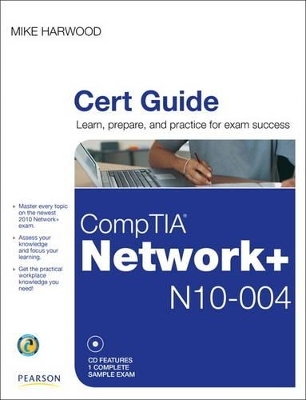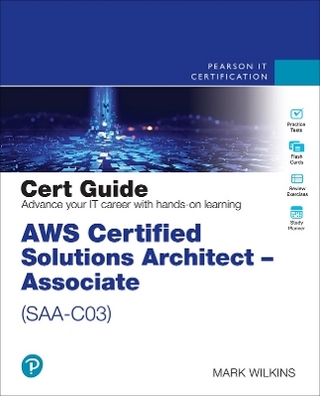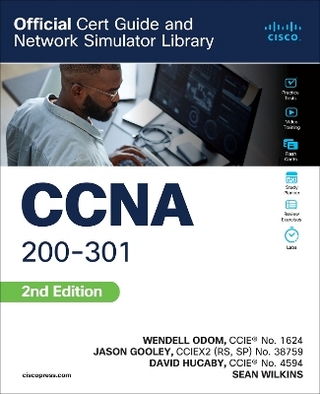
CompTIA Network+ (N10-004) Cert Guide
Pearson IT Certification
978-0-7897-4559-0 (ISBN)
- Titel ist leider vergriffen;
keine Neuauflage - Artikel merken
Master every topic on the newest 2010 Network+ exam.
Assess your knowledge and focus your learning.
Get the practical workplace knowledge you need!
Start-to-finish Network+ preparation from top network administrator, consultant, and best-selling Network+ author Mike Harwood!
Master every Network+ topic!
Networking components, devices, media, and connectors
TCP/IP protocols, addressing, and routing
Ethernet networking standards
Wireless networks
Wide area networks
The OSI Model
Network performance and optimization
Troubleshooting procedures and best practices
Command-line networking tools
Network management tools
Documentation procedures
Network access security
Security technologies and malicious software
Test your knowledge, build your confidence, and succeed!
Packed with visuals to help you learn fast
Dozens of troubleshooting scenarios
Real-world Network+ prep advice from experts
Easy-to-use exam preparation task lists
From Mike Harwood, professional network systems manager, consultant, and author of three best-selling books on the Network+ exam
CD Features 1 Complete Sample Exam
Detailed explanations of correct and incorrect answers
Multiple test modes
Random questions and order of answers
Shelving Category: Network Certification
Mike Harwood (MCSE, A+, Network+, Server+, Linux+) has more than 14 years experience in information technology and related fields. He has held a number of roles in the IT field including network administrator, instructor, technical writer, website designer, consultant, and online marketing strategist. Mike has been a regular on-air technology contributor for CBC radio and has coauthored numerous computer books, including the Network+ Exam Cram published by Pearson.
Introduction 3
How This Book Helps You 4
Exam Objectives and Chapter Organization 4
Instructional Features 18
Network Hardware and Software Requirements 19
Advice on Taking the Exam 20
Chapter 1 Introduction to Computer Networking 23
What Is a Network? 24
LANs and WANs 25
Peer-to-Peer Versus Client/Server Networks 28
The Peer-to-Peer Networking Model 28
Advantages of Peer-to-Peer Networks 29
Disadvantages of Peer-to-Peer Networks 30
The Client/Server Networking Model 30
Servers 31
Client Computers 32
Advantages of Client/Server Networking 32
Disadvantages of Client/Server Networking 32
Distributed and Centralized Computing 33
Virtual Private Networks (VPN) 34
Components of the VPN Connection 35
VPN Pros and Cons 35
Virtual Local Area Network (VLAN) 36
VLAN Membership 37
Protocol-Based VLANs 37
Port-Based VLANs 38
MAC Address-Based VLANs 38
VLAN Segmentation 39
LAN Topologies 40
Physical and Logical Topologies 41
Bus Topology 41
Star Topology 42
Ring Topology 44
Wired Mesh Topology 45
Wireless Network Topologies 47
Infrastructure Wireless Topology 47
Ad Hoc Wireless Networking 48
Point-to-Point, Point-to—Multipoint, and Mesh-Wireless Topology 48
Point-to-Point Networks 48
Point-to-Multipoint 50
Mesh Networks 50
Hybrid Topologies 51
Summary 52
Chapter 2 Media and Connectors 61
Networking Media 62
Media Interference 62
Data Transmission Rates 63
Media Length 63
Secure Transmission and Physical Media 64
Installation and Repair 65
Simplex, Half-Duplex, and Full-Duplex 65
Cable Media 66
Twisted-Pair Cable 67
Coaxial Cable 69
Fiber-Optic Cable 70
Media Connectors 72
RJ Connectors 72
F-Type Connectors and RG-59/RG-6 Cables 73
RS-232 Standard 74
Fiber Connectors 74
IEEE 1394 (FireWire) 75
Universal Serial Bus Connectors (USB) 76
Cable Summary 76
Wiring Standards and Specialized Cable 77
568A and 568B Wiring Standards 77
Straight Versus Crossover Cable 78
Rollover and Loopback Cables 80
Components of Wiring Distribution 80
Network Cross Connects 81
Horizontal Cabling 81
Vertical Cable 82
Patch Panels 83
Type 66 and Type 110 Punchdown Blocks 84
MDF and IDF 85
Demarcation Point 86
Verify Wiring Installation and Termination 87
Summary 89
Chapter 3 Networking Components and Devices 99
Common Network Devices 100
Hubs 100
Network Switches 102
Switching Methods 105
Advanced Switch Features 105
Power over Ethernet (PoE) 106
Trunking 106
Port Authentication 107
Working with Hubs and Switches 107
Hub and Switch Ports 107
Hub and Switch Indicator Lights 109
Rack-Mount, Stackable, and Freestanding Devices 109
Managed Hubs and Switches 109
Repeaters 110
Bridges 110
Bridge Implementation Considerations 111
Types of Bridges 114
Routers 114
Gateways 117
Modems 118
Modem Connection Speeds 119
Network Interface Cards (NIC) 120
Types of Network Interfaces 121
Installing Network Cards 123
Media Converters 124
Firewalls 125
DHCP Server 126
Specialized Network Devices 127
Multilayer and Content Switches 127
Intrusion Detection and Prevention Systems 128
Load Balancer 129
Multifunction Network Devices 129
DNS Server 129
Bandwidth Shaper 130
Proxy Server 131
CSUs/DSUs 133
Network Devices Summary 134
Summary 136
Chapter 4 Understanding the TCP/IP Protocol Suite 145
A Brief Introduction to Protocols 146
Protocols from the Sending Device 147
Protocols on the Receiving Device 147
Transmission Control Protocol/Internet Protocol (TCP/IP) Protocol Suite 148
Internet Protocol (IP) 149
Transmission Control Protocol (TCP) 149
User Datagram Protocol (UDP) 150
File Transfer Protocol (FTP) 151
Secure Shell (SSH) 152
Secure File Transfer Protocol (SFTP) 152
Trivial File Transfer Protocol (TFTP) 153
Simple Mail Transfer Protocol (SMTP) 153
Hypertext Transfer Protocol (HTTP) 154
Hypertext Transfer Protocol Secure (HTTPS) 154
Post Office Protocol Version 3/Internet Message Access Protocol Version 4 (POP3/IMAP4) 155
Telnet 155
Internet Control Message Protocol (ICMP) 156
Address Resolution Protocol (ARP) and Reverse Address Resolution Protocol
(RARP) 156
Network Time Protocol (NTP) 157
Network News Transfer Protocol (NNTP) 157
Secure Copy Protocol (SCP) 158
Lightweight Directory Access Protocol (LDAP) 158
Internet Group Management Protocol (IGMP) 158
Domain Name System (DNS) 159
The DNS Namespace 160
Types of DNS Entries 162
DNS in a Practical Implementation 163
Simple Network Management Protocol (SNMP) 163
Components of SNMP 164
SNMP Management Systems 164
SNMP Agents 165
Management Information Bases (MIB) 165
SNMP Communities 166
Dynamic Host Configuration Protocol (DHCP) 167
Transport Layer Security 170
Session Initiation Protocol 170
Real-time Transport Protocol (RTP) 171
TCP/IP Protocol Suite Summary 171
Identifying Common TCP/IP Port Numbers 173
Summary 175
Chapter 5 TCP/IP Addressing and Routing 185
Identifying MAC Addresses 186
Understanding IPv4 Addressing Fundamentals 187
General IP Addressing Principles 188
IPv4 Addressing 188
IPv4 Address Types 190
Distributing IPv4 Addresses to the Network 191
Static Addressing 191
Dynamic Addressing 191
Bootstrap Protocol (BOOTP) 191
APIPA and IPv4 192
Broadcast Addresses and “This Network” 193
Classless Interdomain Routing (CIDR) 193
Default Gateways 194
Understanding Subnetting 195
Public and Private IP Address Schemes 198
Private Address Ranges 199
Practical Uses of Public and Private IP Addressing 200
IPv6 Addressing 201
Identifying IPv6 Addresses 201
IPv6 Address Types 202
Differentiating Between Routable and Routing Protocols 204
Routable Protocols 204
Routing Protocols 205
Distance-Vector Routing Protocols 206
Link-State Routing Protocols 208
NAT, PAT, and SNAT 209
Summary 211
Chapter 6 Ethernet Networking Standards 221
Characteristics Specified in the IEEE 802 Standards 223
Speed 223
Access Methods 223
Carrier Sense Multiple Access/Collision Detection 224
CSMA/CA 225
Token Passing 226
Bonding 226
Topology 226
Media 227
Differentiating Between Baseband and Broadband Signaling 227
Baseband 227
Broadband 227
Ethernet Standards 228
10Base2 228
10BaseT 229
10BaseFL 230
Fast Ethernet 230
100BaseTX 231
100BaseT4 231
100BaseFX 231
Fast Ethernet Comparison 231
Gigabit Ethernet 232
1000BaseX 232
1000BaseT 233
10Gigabit Ethernet 234
10GBaseSR/SW 234
10GBaseLR/LW 235
10GBaseER/EW 235
10GBaseT 236
Summary 236
Chapter 7 Wireless Networking 245
Understanding Wireless Devices 246
Wireless Access Point 246
Wireless Antennas 248
Antenna Ratings 249
Types of Wireless Antennas 249
802.11 Wireless Standards 251
The Magic Behind 802.11n 254
Wireless Radio Channels 254
Spread Spectrum Technology 257
Frequency-Hopping Spread Spectrum (FHSS) Technology 257
Direct-Sequence Spread Spectrum (DSSS) Technology 258
Orthogonal Frequency Division Multiplexing 258
FHSS, DSSS, OFDM, and 802.11 Standards 258
Beacon Management Frame 259
Configuring and Troubleshooting the Wireless Connection 260
Configuring Communications Between Wireless Devices 262
Troubleshooting Wireless Signals 264
Site Surveys 265
Troubleshooting AP Coverage 266
Wireless Troubleshooting Checklist 267
Securing Wireless Networks 268
Defining Access Control, Authentication, Authorization, and Encryption 268
Wireless Authentication and Encryption Methods 269
Wired Equivalent Privacy (WEP) 270
Wi-Fi Protected Access (WPA) 270
Temporal Key Integrity Protocol (TKIP) 271
802.1X 272
Securing the Access Point 273
Summary 273
Chapter 8 Wide Area Networking 283
Public and Private Networks 284
Public Networks 284
Public Switched Telephone Network (PSTN) 284
The Internet 285
Advantages and Disadvantages of Public Networks 286
Private Networks 286
Switching Methods 287
Packet Switching 288
Virtual-Circuit Packet Switching 289
Datagram Packet Switching 289
Circuit Switching 290
Message Switching 290
Comparing Switching Methods 291
WAN Technologies 292
X.25 293
Frame Relay 293
T-Carrier Lines 295
T1/E1/J1 Lines 295
T3 Lines 297
SONET/OCx Levels 297
Asynchronous Transfer Mode (ATM) 298
Integrated Services Digital Network (ISDN) 299
Basic Rate Interface (BRI) 301
Primary Rate Interface (PRI) 301
Comparing BRI and PRI ISDN 301
WAN Technology Summary 301
Internet Access Technologies 302
POTS Internet Access 303
POTS Troubleshooting Procedures 303
Troubleshooting Poor Connection Speeds 305
Modem-Specific Troubleshooting 306
xDSL 307
Cable Internet Access 310
Satellite Internet Access 313
Wireless Wide Area Networking 315
Summary 316
Chapter 9 OSI Model 325
OSI Reference Model 101 326
Layer 1: The Physical Layer 328
Layer 2: The Data Link Layer 329
Layer 3: The Network Layer 329
Switching Methods 330
Network Layer Addressing 331
Layer 4: The Transport Layer 331
Connection-Oriented Protocols 332
Connectionless Protocols 332
Flow Control 333
Layer 5: The Session Layer 333
Layer 6: The Presentation Layer 333
Layer 7: The Application Layer 334
OSI Model Summary 334
The Layers at Which Devices Operate 335
Hubs 336
Switches 336
Bridges 336
Routers 336
NICs 336
Wireless Access Points (APs) 337
Summary of the Layers at Which Devices Operate 337
TCP/IP Protocol Suite Summary 337
Summary 340
Chapter 10 Network Performance and Optimization 349
Understanding Uptime 350
Understanding the Risks 352
RAID 353
RAID 0 354
Advantages of RAID 0 354
Disadvantages of RAID 0 355
Recovering from a Failed RAID 0 Array 355
RAID 1 355
Advantages of RAID 1 357
Disadvantages of RAID 1 357
Recovering from a Failed RAID 1 Array 358
RAID 5 358
Advantages of RAID 5 358
Disadvantages of RAID 5 359
Recovering from a RAID 5 Array Failure 359
RAID 10 360
Choosing a RAID Level 361
Hardware and Software RAID 362
Other Fault-Tolerance Measures 363
Link Redundancy 363
Using Uninterruptible Power Supplies 364
Why Use a UPS? 365
Power Threats 365
Using Redundant Power Supplies 366
Server and Services Fault Tolerance 366
Using Standby Servers 366
Server Clustering 367
Preparing for Memory Failures 368
Managing Processor Failures 368
Disaster Recovery 368
Backup Methods 368
Full Backups 369
Incremental Backups 370
Differential Backups 370
A Comparison of Backup Methods 371
Backup Rotation Schedules 371
Offsite Storage 372
Backup Best Practices 373
Hot and Cold Spares 374
Hot Spare and Hot Swapping 374
Cold Spare and Cold Swapping 375
Recovery Sites 375
Cold Site 375
Hot Site 376
Warm Site 376
Network Optimization Strategies 377
QoS 377
Latency-Sensitive High-Bandwidth Applications 378
Voice over Internet Protocol (VoIP) 378
Video Applications 379
Traffic Shaping 379
Load Balancing 381
Caching Engines 381
Summary 382
Chapter 11 Troubleshooting Procedures and Best Practices 393
The Art of Troubleshooting 394
Troubleshooting Servers and Workstations 394
General Troubleshooting Considerations 395
Troubleshooting Methods and Procedures 396
Step 1: Information Gathering–Identify Symptoms and Problems 397
Information from the Computer 397
Information from the User 398
Observation Techniques 399
Effective Questioning Techniques 399
Step 2: Identify the Affected Areas of the Network 399
Step 3: Determine if Anything Has Changed 400
Changes to the Network 400
Changes to the Server 401
Changes to the Workstation 402
Step 4: Establish the Most Probable Cause 402
Step 5: Determine if Escalation Is Necessary 403
Step 6: Create an Action Plan and Solution Identifying Potential Effects 403
Step 7: Implement and Test the Solution 404
Step 8: Identify the Results and Effects of the Solution 405
Step 9: Document the Solution and the Entire Process 406
Troubleshooting the Network 407
Troubleshooting Wiring 407
Where the Cable Is Used 408
Wiring Issues 409
Crosstalk 409
Near-End Crosstalk (NEXT) 409
Far-End Crosstalk (FEXT) 409
Electromagnetic interference (EMI) 409
Attenuation 410
Open Impedance Mismatch (Echo) 410
Shorts 410
Managing Collisions 410
Troubleshooting Infrastructure Hardware 411
Configuring and Troubleshooting Client Connectivity 413
Verifying Client TCP/IP Configurations 413
Setting Port Speeds and Duplex 415
Troubleshooting Incorrect VLANs 416
Identifying Issues That Might Need Escalation 417
Troubleshooting Wireless Issues 418
Troubleshooting Wireless Signals 418
Troubleshooting Wireless Configurations 420
Summary 421
Chapter 12 Command-Line Networking Tools 431
Common Networking Utilities 432
The ping Utility 432
Switches for ping 434
Troubleshooting Steps with ping 435
Ping Error Messages 436
The Destination Host Unreachable Message 437
The Unknown Host Message 438
The traceroute Utility 439
Reviewing tracert Command Printouts 441
The traceroute Command 444
The mtr Utility 445
The arp Utility 445
The ARP Cache 445
Switches for arp 446
The arp Command Printout 447
The arp ping Utility 447
The netstat Utility 448
The netstat Command Printouts 450
netstat -e 450
netstat -a 451
netstat -r 452
netstat -s 453
The nbtstat Utility 454
The ipconfig and ifconfig Utilities 456
The ipconfig Utility 457
The ipconfig Command Printouts 458
The ifconfig Command Printout 460
The nslookup and dig Utilities 461
The nslookup Utility 461
The nslookup Command Printout 463
The dig Utility 464
The dig Command Printout 465
The host Command 466
The route Utility 466
Summary 468
Chapter 13 Network Management Tools and Documentation Procedures 479
Documentation Management 480
Wiring Schematics 481
Physical and Logical Network Diagrams 484
Physical Network Documentation 484
Logical Network Documentation 485
Baselines 487
Policies, Procedures, Configurations, and Regulations 488
Policy Documentation 488
Network Procedure Documentation 489
Configuration Documentation 490
Regulations 491
Monitoring the Network to Identify Performance 492
Throughput Testing 493
Port Scanners 495
Network Testing 498
Performance Testing 498
Load Testing 498
Stress Testing 499
Logging 499
Security Logs 500
Application Logs 501
System Logs 502
History Logs 502
Log Management 503
Networking Tools 503
Wire Crimpers 504
Strippers and Snips 504
Punchdown Tools 505
Cable Certifiers 505
Voltage Event Recorders 506
Temperature Monitors 506
Toner Probes 508
Protocol Analyzer 509
Media/Cable Testers 509
Media Testers 510
TDR 510
OTDR 510
Multimeter 511
Network Qualification Tester 512
Butt Set 512
Wireless Detector 512
Summary 513
Chapter 14 Network Access Security 525
Understanding Network Security Threats 526
Security Responsibilities of a Network Administrator 527
Physical and Logical Security 528
Physical Security 528
Network Hardware and Server Room Access 529
Lock and Key 529
Swipe Card and PIN Access 529
Biometrics 530
Hardware Room Best Practices 531
Logical Security 532
Firewalls 532
The Purpose and Function of a Firewall 534
Stateful and Stateless Firewalls 536
Firewall Methods 536
Network Layer Firewalls 536
Circuit-Level Firewalls 537
Application-Layer Firewalls 537
Demilitarized Zones 538
Intrusion Detection and Intrusion Prevention Systems 539
Network Access Security 539
Access Control Lists 540
Access Control and MAC Filtering 540
TCP/IP Filtering 540
Port Blocking/Filtering 541
Remote Access Protocols and Services 542
Routing and Remote Access Service (RRAS) 542
SLIP 543
PPP 543
PPPoE 544
Tunneling and Encryption 545
SSL VPNs 546
VPN Concentrators 546
Point-to-Point Tunneling Protocol (PPTP) 547
Layer Two Tunneling Protocol (L2TP) 548
Advantages of L2TP and PPTP 548
Inside IPsec 548
Authentication Headers 549
Encapsulating Security Payloads 549
IPsec Transmission Modes 550
Remote Control Protocols 550
Summary 551
Chapter 15 Security Technologies and Malicious Software 561
Authentication, Authorization, and Accounting (AAA) 562
Authentication 562
Password Policies 562
Password Strength 563
Multifactor Authentication 565
Authentication Tokens 565
Biometrics 565
Multifactor Authentication/Two-Factor Authentication 566
Authorization 566
Accountability 567
RADIUS and TACACS+ 568
RADIUS 568
TACACS+ 570
Understanding Cryptography Keys 570
Kerberos Authentication 572
Public Key Infrastructure 573
Components of a PKI 574
Certificates 575
Certificate Stores 576
Trusts 576
Certificate Authorities (CAs) 577
Public CAs 577
Private CAs 577
Network Access Control 578
Mandatory Access Control (MAC) 578
Discretionary Access Control (DAC) 579
Rule-Based Access Control (RBAC) 579
Role-Based Access Control (RBAC) 579
Remote Authentication Protocols 580
Using Secure Protocols 581
Malicious Software 582
Malware Distribution 583
Malware Payloads 584
More About Viruses 585
More About Trojan Horses and Worms 586
Comparing Malware Types 586
Types of Attacks 587
Denial of Service and Distributed Denial of Service Attacks 587
Other Common Attacks 589
An Ounce of Prevention 590
Maintaining Operating System Software 592
Reasons to Use a Service Pack 593
When to Use a Service Pack 593
How to Apply a Service Pack 594
Server Patches 595
Summary 596
Appendix A Answers to the Review Questions 605
Index 639
Elements on the CD-ROM:
Appendix B Memory Tables
Appendix C Memory Tables Answer Key
Glossary
TOC, 9780789745590, 7/8/10
| Erscheint lt. Verlag | 26.8.2010 |
|---|---|
| Verlagsort | Upper Saddle River |
| Sprache | englisch |
| Maße | 239 x 196 mm |
| Gewicht | 1326 g |
| Themenwelt | Mathematik / Informatik ► Informatik ► Netzwerke |
| Informatik ► Weitere Themen ► Zertifizierung | |
| ISBN-10 | 0-7897-4559-3 / 0789745593 |
| ISBN-13 | 978-0-7897-4559-0 / 9780789745590 |
| Zustand | Neuware |
| Haben Sie eine Frage zum Produkt? |
aus dem Bereich


